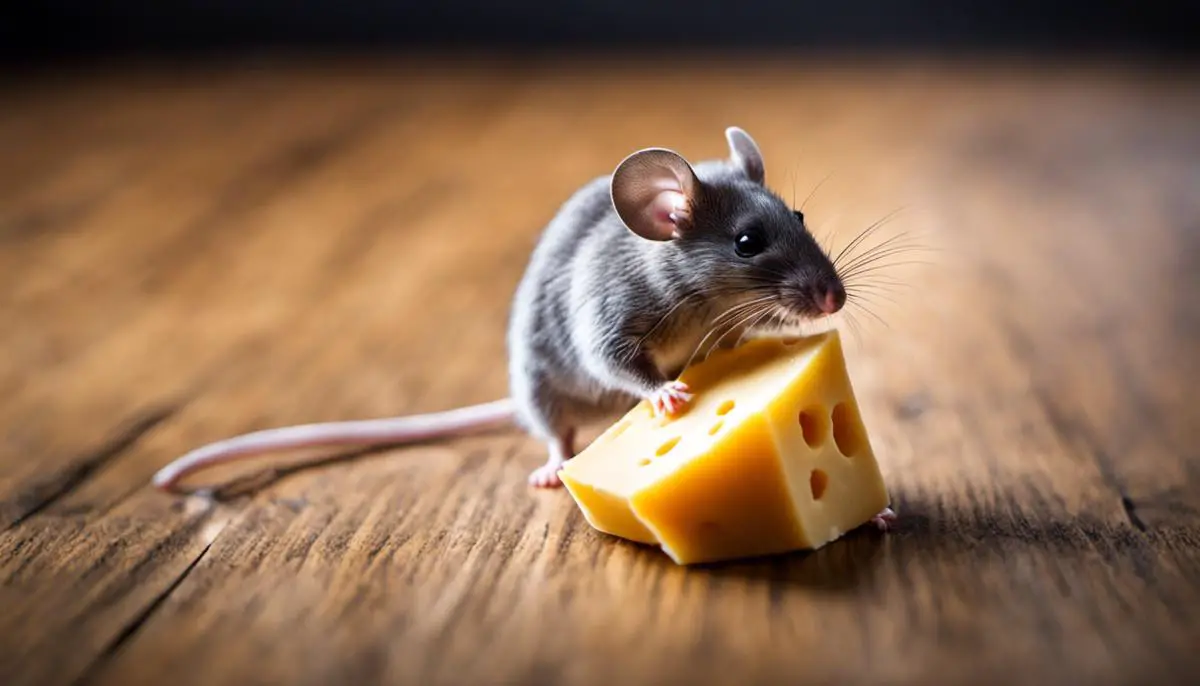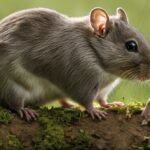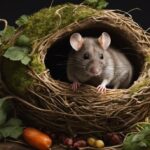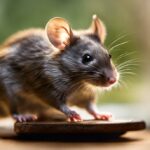Being cognizant of mouse behavior and knowing how to prevent them from nesting in your home is vital to effective mouse control. As loathsome as these small creatures can be, one must strive to learn and comprehend their eating preferences, nesting habits, and the far too numerous signs that they have taken up residence within your home. Prevention, of course, is the best method of control. The aim is to erase all that may attract mice, ensuring your home remains a no-go zone for them.
However, in the unfortunate circumstance that mice find their way into your home, knowing how to use various trapping techniques and baits properly gives you the upper hand in the battle against these unwelcome guests.
Cleanup is not a task for the timid, especially considering the potential spread of diseases. This underlines the importance of seeking professional help in severe cases.
Understanding Mouse Behavior
Understanding Mouse Behavior
Mouse behavior is influenced by various factors, making it essential knowledge for effective mouse control. Mice are primarily nocturnal creatures, meaning they are most active during nighttime. They are also believed to have poor eyesight but exceptional hearing, touch, taste, and smell, which they use to navigate and locate food sources.
Eating Habits of Mice
When it comes to diet, mice are virtually omnivorous, but they exhibit a preference for grains, seeds, and sweets. Each mouse needs to consume about 1/10 of its body weight in food daily, meaning that a small infestation can rapidly consume or contaminate large quantities of food. Mice also habitually nibbling small amounts from various food sources, making detection based on food consumption somewhat difficult.
Nesting Preferences of Mice
In terms of nesting, mice prefer dark, secluded places that protect them from predators and elements. This is why they are so often found nesting in wall cavities, attics, basements, closets, and under appliances. They use materials like paper, insulation, and any available soft materials to build their nests. Understanding these preferences can help you identify likely nesting areas and apply effective control measures.
Signs of Mouse Presence in Your Home
Recognizing signs of mice in your home is crucial for early detection and control. Typical signs include:
- Droppings: Mouse droppings, about the size of rice grains, can usually be found along their travel paths, feeding areas, or near their nests.
- Gnaw marks: Mice constantly gnaw on various materials, including both foodstuffs and non-food materials such as wood, plastic, and wires, to keep their teeth sharp and short.
- Scratching or scurrying sounds: You may hear mice moving around at night since they are most active during this period.
- Nesting material: Finding piles of shredded paper, fabric, or other soft materials is a good sign of their nesting activity.
- Uneaten pet food: Mice may find and consume food intended for your pets.
- Unpleasant odor: A strong musky odor is a clear sign of a significant mice infestation.
By understanding mouse behavior and knowing the signs of their presence, you can begin to apply practical and effective mouse control tactics with higher success rates.

Preventing Infestation
Identifying Common Attractants for Mice
Mice are small creatures in search of shelter, food, and water. If your home provides these, it may become an attractive destination for these rodents. The common attractants for mice include easy-to-access food such as leftovers, pet food, and bird seeds. Mice are also attracted to cluttered environments that provide hiding places like piles of paper, garments, and boxes.
Eliminating Food Sources
To prevent a mouse infestation, start by removing their potential food sources. Seal your food in airtight containers, and clean up immediately after meals to avoid leaving crumbs behind. Don’t leave dishes in the sink overnight; cover the fruit bowl. Gradually reduce the quantity of food your pets consume to avoid leftovers and ensure full consumption of their meals before sunset. Cleaning bird feeders can also help, as bird seed is a common attractant for mice.
Reducing Clutter and Sealing Entry Points
Eliminating hiding places is the next essential step in preventing a mouse infestation. Keep your home, especially storage areas, neat and tidy. Clean up clutter and organize your belongings in sealed plastic containers as opposed to cardboard boxes, as mice can chew through these.
Mice can squeeze through small holes the size of a dime, so it’s important to identify and seal any potential entry points. Check around pipes, windows, doors, vents, or any other gaps and holes in your home’s structure. Use materials such as steel wool, caulk, or foam insulation to fill in these gaps.
Proper Waste Management
Improper waste management can also attract mice. Always secure your trash cans with tight-fitting lids and ensure you take the trash out regularly. Compost bins should be well-contained and located as far away from the house as possible.
Maintain Your Yard
Mice are attracted to overgrown vegetation as they provide perfect hiding spots. Trim your bushes and overgrown branches, and get rid of any piles of wood or compost near your home. This will make your yard less attractive to mice.
When to Seek Professional Help
If you’ve tried these measures and you still find evidence of mice, such as droppings, chew marks, or a stale smell, it’s time to consult a pest control professional. They will not only help you get rid of current infestations, but they can also offer advice tailored to your home for long-term mouse control.
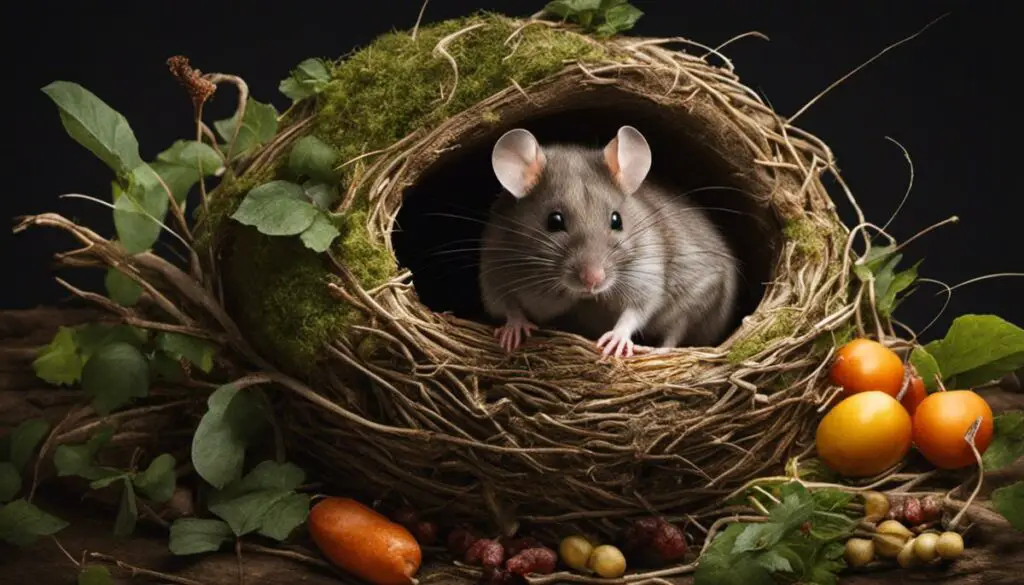
Mouse Traps & Baits
Types of Mouse Traps
There are numerous options for mouse traps available today. The most common type is the snap trap, which employs a quick trigger system to catch the mice. Catch and release or live traps, on the other hand, are a more humane option as they allow for the rodent to be released safely back into the wild.
Glue traps involve the use of a strong adhesive that will immobilize a mouse when it steps on the surface of the trap. Electronic traps are also available, delivering a lethal amount of electricity when a mouse enters the trap.
Multi-catch options are practical for larger infestations since they can hold multiple mice at a time. Finally, poison bait traps house a food-based poison that the mouse can consume and, later on, die from the effects of the poison.
Effective Mouse Trap Baits
The best bait for a mouse trap depends on what the mice in your area prefer to eat. Ordinarily, cheese is often depicted as the default bait. However, in real life, mice are generally more attracted to foods with high calories. Food items like peanut butter, chocolate, sweet fruits, and high-protein foods such as bacon or nuts can be highly effective baits.
It is important to note that the bait should neither be too hard nor too messy to handle and place on the trap. Small amounts can often be more effective than large quantities because a mouse can sometimes take a large bait without setting off the trap.
Factors Attracting Mice to Baits
Mice have an acute olfactory sense that attracts them to food sources. High-calorie or high-protein foods tend to produce strong smells that can draw mice. Mice are also attracted to warm, comfortable spaces, and they are curious creatures. So, placing the traps in appropriate positions can play as great a role as the bait itself in catching them.
Proper Placement of Mouse Traps
Mice typically run alongside walls and baseboards since they prefer to stay out of open spaces where they are more vulnerable to predators. Therefore, traps should be placed along walls, behind furniture, or in other secluded areas.
Mice also tend to frequent regions with available food sources, so traps can be stationed in the kitchen or pantry. It’s also important to keep in mind that mice have poor eyesight but a keen sense of touch, feeling their way along walls through their whiskers. Hence, placing traps perpendicular to a wall with the bait side nearest to the wall could increase the chances of capture.
Finally, constant inspection and changing of traps and baits increase the effectiveness of mouse control as it prevents mice from becoming trap-shy and recognizes the best baits and locations for trapping in your specific situation.

Cleaning Up After Mice
Why is Safe and Effective Cleanup Important?
Following a mouse infestation, it’s crucial to practice safe and effective cleanup methods to prevent the potential spread of diseases that rodents can carry. Mice can transmit harmful pathogens through their urine, feces, and saliva, which may linger even after the mice themselves are gone. Your health and the health of your family could be at risk if the cleanup process isn’t handled properly. Hantavirus, leptospirosis, and salmonellosis are just a few examples of diseases that can be spread by mice.
Perform Initial Cleaning
Wearing gloves and a mask to protect yourself from potential biohazards, begin the cleanup process by disposing of any mouse nests and dead mice. Items that have come into contact with rodents should be disinfected to kill potentially harmful viruses and bacteria. Use a commercial disinfectant or a mixture of 1 part bleach to 10 parts water.
Mop floors and clean countertops with disinfectant. For rugs and upholstered furniture, steam cleaning can help to destroy any lingering pathogens. It’s also a good idea to wash bedding and clothing that may have been in contact with rodents in hot water.
Prevent Future Infestations
After the area is clean and disinfected, your next step is to prevent future infestations. Inspect your home for gaps or cracks that could serve as entry points for mice and fill them with steel wool or caulk. Maintain cleanliness in areas where food is stored and dispose of garbage regularly to make your home less attractive to rodents.
When Professional Help is Needed
If the mouse infestation is severe or continues despite your efforts, it may be time to call in professionals. Pest control experts have the training and equipment to handle large infestations safely and efficiently, and they can also provide additional advice for keeping your home rodent-free in the future.
Lastly, Individuals should seek professional cleaning services if a high amount of rodent activity is noted, if the space to be cleaned is very large, or if the person assigned does not have the physical capability to do the cleanup tasks.

Having sought to understand the behavior of mice and how to prevent their infestation in your house, it is essential to implement these practical measures to ensure your home remains mouse-free. The types of mouse traps and baits you choose to utilize are integral components in this battle. The position of these tools must be strategic to ensure effective mouse control. After an infestation, it is direly important to enlist the help of a professional to ensure a safe and effective cleanup.
Mice can be carriers of harmful diseases. Hence, a thorough and proper cleanup is essential to prevent any probable health-related issues. Let the knowledge acquired serve as a guide against current infestations and the potential threats of recurrence. It’s a victory well worth celebrating when you can finally pronounce your home mouse-free!

